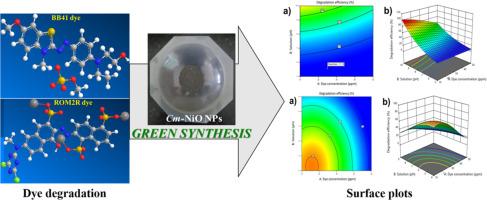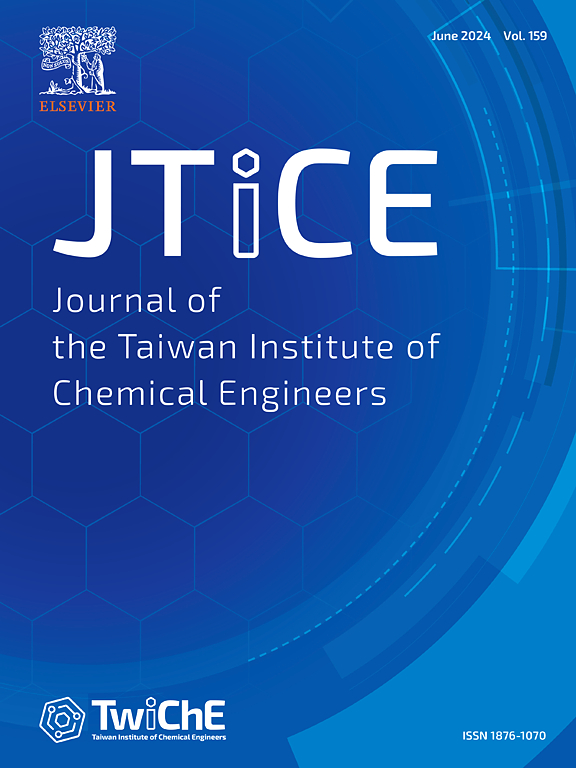Enhanced photocatalytic activity of BB41 and ROM2R dyes using green synthesized NiO nanoparticles: A response surface methodology approach
IF 5.5
3区 工程技术
Q1 ENGINEERING, CHEMICAL
Journal of the Taiwan Institute of Chemical Engineers
Pub Date : 2024-11-06
DOI:10.1016/j.jtice.2024.105816
引用次数: 0
Abstract
Background
NiO NPs are recognized for their potential in catalysis, energy storage, and environmental remediation. Green synthesis using plant extracts, such as Cucumis maderaspatanus L. (CmL.) leaves, offers an eco-friendly approach. This study focuses on synthesizing and analyzing the structural, optical, and photocatalytic properties of Cm-NiO NPs.
Methodology
Cm-NiO NPs were synthesized using CmL. leaf extract and calcinated at 300, 500, and 700 °C. XRD confirmed a face-centered cubic structure. Band gap values were 3.36 eV at 300 °C, 2.98 eV at 500 °C, and 3.15 eV at 700 °C. TEM showed spherical particles of 17.81 nm. The point of zero charge (pHpzc) was pH 7.95. The photocatalytic activity was tested on BB41 and ROM2R dyes under varying pH (4 – 10), dye concentrations (10 – 50 ppm), catalyst amounts (0.1 – 1.0 mg/mL), and light sources. Scavenger studies identified reactive compounds. Response surface methodology (RSM) optimized the degradation process. LC-MS analyzed degradation products, and ECOSAR software estimated their toxicity.
Significant Findings
Cm-NiO NPs showed high photocatalytic efficiency, degrading 93.60 % of BB41 and 88.76 % of ROM2R under UV light (250 W, 365 nm). The nanoparticles demonstrated a face-centered cubic structure and a pHpzc of 7.95. RSM effectively optimized the process, and toxicity analysis suggested a potential for environmental applications.

利用绿色合成的氧化镍纳米粒子提高 BB41 和 ROM2R 染料的光催化活性:响应面方法学
背景氧化镍氮氧化物在催化、储能和环境修复方面的潜力已得到公认。利用植物提取物(如 Cucumis maderaspatanus L. (CmL.) 叶片)进行绿色合成是一种环保方法。本研究的重点是合成和分析 Cm-NiO NPs 的结构、光学和光催化特性。XRD 证实其为面心立方结构。带隙值在 300 °C 时为 3.36 eV,500 °C 时为 2.98 eV,700 °C 时为 3.15 eV。TEM 显示出 17.81 纳米的球形颗粒。零电荷点(pHpzc)为 pH 7.95。在不同的 pH 值(4 - 10)、染料浓度(10 - 50 ppm)、催化剂用量(0.1 - 1.0 mg/mL)和光源条件下,对 BB41 和 ROM2R 染料进行了光催化活性测试。清除剂研究确定了反应性化合物。响应面方法(RSM)优化了降解过程。LC-MS 对降解产物进行了分析,ECOSAR 软件对其毒性进行了估计。重要发现Cm-NiO NPs 显示出很高的光催化效率,在紫外光(250 W,365 nm)下降解了 93.60 % 的 BB41 和 88.76 % 的 ROM2R。纳米粒子呈现面心立方结构,pHpzc 为 7.95。RSM 有效地优化了工艺,毒性分析表明其具有环境应用潜力。
本文章由计算机程序翻译,如有差异,请以英文原文为准。
求助全文
约1分钟内获得全文
求助全文
来源期刊
CiteScore
9.10
自引率
14.00%
发文量
362
审稿时长
35 days
期刊介绍:
Journal of the Taiwan Institute of Chemical Engineers (formerly known as Journal of the Chinese Institute of Chemical Engineers) publishes original works, from fundamental principles to practical applications, in the broad field of chemical engineering with special focus on three aspects: Chemical and Biomolecular Science and Technology, Energy and Environmental Science and Technology, and Materials Science and Technology. Authors should choose for their manuscript an appropriate aspect section and a few related classifications when submitting to the journal online.

 求助内容:
求助内容: 应助结果提醒方式:
应助结果提醒方式:


